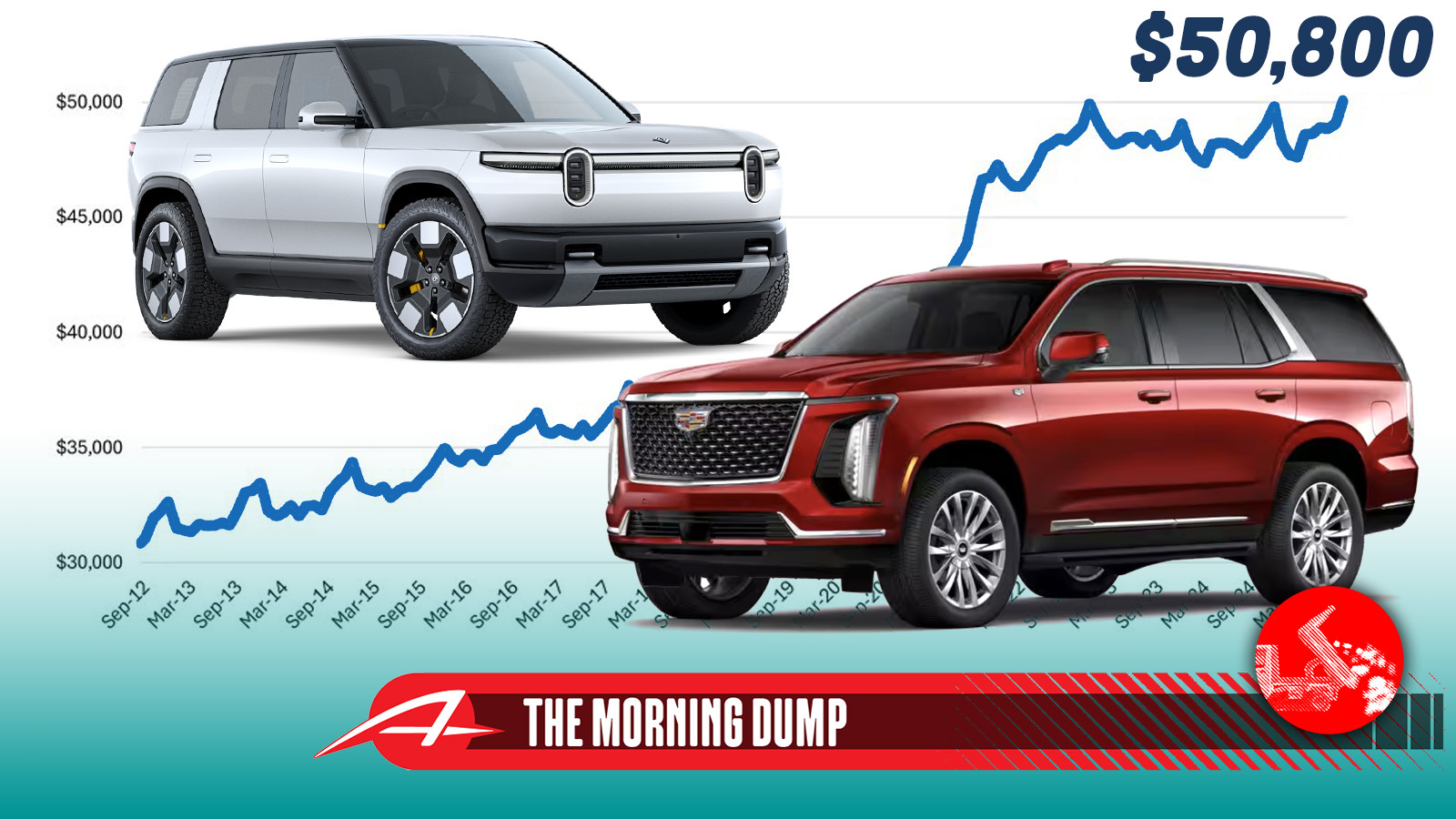The day has come. The day I’ve long expected and, in some ways, feared. The average transaction price for a new car finally eclipsed $50,000. This isn’t a surprise, and it isn’t purely a sign of cars getting more expensive. It’s more a reflection of who is actually buying cars and the realities of the modern economy.
The Morning Dump today is going to focus on the world we live in now, versus the world automakers wished we lived in. I’ll start with the big $50,000 number, which does have a little to do with electric vehicle sales. It’s not like those sales are making people money, as GM is going to take a huge hit due to the loss of EV momentum.
While everyone dreams of alternative fuel sources, Brazil is one of the few places where that’s actually happening. It’s one of the reasons why BYD is expanding in the country. And while we’re talking about the boys from Brazil… Mercedes has a new vision for its brand.
The Average Transaction Price (ATP) chart from KBB/Cox Automotive has almost hit the $50,000 mark twice before. The first time was back in 2022 at the height of pandemic supply shortages. The second time was about a year ago. Finally, for the first time ever, the number eclipsed the $50,000 mark in September.
The number has been hovering close enough to the $50,000 mark that it’s not particularly important that we’ve crossed it. What’s the difference between $50,080 and $49,760 to the average car buyer? ATP essentially takes the total revenue of cars sold in a given period and divides it by the number of vehicles sold, giving you a price that’s more accurate than the average MSRP because it takes into account what the vehicle transacted for after all of the various offsets.
What’s interesting to me here is that this is not merely a reflection of the lack of affordable cars. That’s a part of it, sure, as are perhaps the first impacts of tariffs. A major reason why the average car was more expensive is that a record number of EVs were sold in the United States, and EVs are more expensive (the average ATP of an EV was $58,124 last month). This means that it’s possible there’s a drop in ATP next month.
I’m more interested in what this means about the average buyer. Car sales are still robust even as cars get more expensive. This means that people buying cars are either stretching their budgets (that’s happening) or are merely rich enough to afford a new car.
“It is important to remember that the new-vehicle market is inflationary. Prices go up over time, and today’s market is certainly reminding us of that. While there are many affordable options out there, many price-conscious buyers are choosing to stay on the sidelines or cruising in the used-vehicle market,” explains Erin Keating, Executive Analyst at Cox Automotive. “Today’s auto market is being driven by wealthier households who have access to capital, good loan rates and are propping up the higher end of the market. Tariffs have introduced new cost pressure to the business, but the pricing story in September was mostly driven by the healthy mix of EVs and higher-end vehicles pushing the new-vehicle ATP into uncharted territory.”
I think I’ve referenced this before, but it does remind me of the debate between two jazz musicians (played perfectly by Wesley Snipes and Denzel Washington) in Mo’ Better Blues. Does the audience not come because they don’t care, or do they not care because you’re not playing what they like?
To put it in automotive terms: Are only wealthy buyers entering the market because they’re the only ones with money, or are carmakers not building the kind of affordable cars people want? It’s probably some of both.
The modern economy provides great income growth for some people and for stockholders. The best way to have money is to have money, because the new increases in wealth will be coming from efficiency gains due to AI. If that’s the case, where does the average worker end up?
Some call this “jobless growth” or, the “K-Shaped economy.” From CNBC:
Consumers in the top 10% of the income distribution accounted for 49.2% of consumer spending in the second quarter, marking the highest level since data started being compiled in 1989, according to Mark Zandi at Moody’s Analytics.
The so-called “K-shaped economy” has performed well so far, at least according to broad economic measures such as GDP and consumption. Yet the growing dependence on a small sliver of consumers at the top carries risks.
Zandi said a deep and prolonged decline in the stock market, which is driving almost all of the wealth gains at the top, could send wider ripples through the economy.
“The economy is being powered in big part by the spending of the extraordinarily well-to-do, who are cheered by the surging value of their stock portfolios,” he said. “If the richly (over) valued stock market were to stumble, for whatever reason, and the well-to-do see more red on their stock tickers than green, they will quickly turn more cautious in their spending, posing a serious threat to the already fragile economy.”
The economy depends on AI adoption to continue at an increasing pace, and for wealthier individuals with stocks to keep spending money. How long will that last?
I’d argue that General Motors is the best-positioned EV company in North America that isn’t Tesla, but that doesn’t mean that all the churn in the electric car market isn’t taking its toll on the automaker.
A recent filing, reported on by the Detroit Free Press, shows that GM plans to take a $1.6 billion writedown from EVs split between $1.2 billion for unused equipment and $400 million for supplier cancellation fees:
“General Motors Company made significant investments and contractual commitments in the development of electric vehicles to help the company’s vehicle fleet comply with emissions and fuel economy regulations that were scheduled to become increasingly stringent,” read the filing. “Following recent U.S. government policy changes, including the termination of certain consumer tax incentives for EV purchases and the reduction in the stringency of emissions regulations, we expect the adoption rate of EVs to slow,” the filing continued. “Our strategic realignment of EV capacity does not impact today’s retail portfolio of Chevrolet, GMC and Cadillac EVs currently in production, and we expect these models to remain available to consumers.”
This equipment will probably be used eventually, but not at the pace initially expected, so GM has to adjust its books.
Brazil made the use of sugar-based ethanol a major part of its path towards energy independence after the gas shocks of the 1970s. The country’s vehicles use a mix of gasoline, bio-diesel, and ethanol to power their vehicles.
Now it looks like the world is getting its first flex-fuel engine-powered PHEV in the form of the BYD Song PRO. From a press release:
BYD founder and CEO Wang Chuanfu said: “After two years of effort by more than 100 Chinese and Brazilian engineers, today our 14 millionth vehicle rolls off the production line equipped with the world’s first plug-in hybrid engine dedicated to biofuel. This is not just a technological breakthrough – it is a green and sustainable solution tailor-made for Brazil.”
He added: “Two years ago, on a visit to Brazil, I realised the potential of ethanol. We then decided that we would bring our plug-in hybrid technology, but with a flex engine developed by and for this country. The car we are delivering today to President Lula is proof that BYD not only invests in Brazil but also co-creates with Brazil unique solutions for the world.”
Brazil is a great place for BYD to expand, as it is arms-length enough with the American government to not be concerned with the fallout from having a BYD plant in the country. Additionally, a flex-fuel vehicle like the Song isn’t going to be sold here anytime soon.
No one buys electric coupes yet, so the fact that every automaker has to show a big EV coupe now is amusing to me. Whatever, this Mercedes-Benz Vision Iconic does look cool.
It’s very Art Deco, with that big throwback grille. This is an EV, so it doesn’t necessarily need a big radiator, but it’s pleasingly dramatic and contrasts well with the deep black paint.
Does it have some crazy concept crap? Yes, it does, which is good!
Mercedes-Benz is researching innovative solar modules that could be seamlessly applied to the bodywork of electric vehicles, similar to a wafer-thin paste. The photovoltaic-active surface could be adaptable to various substrates. When applied to the entire vehicle surface of the Iconic Vision, additional range could be harnessed from the sun, depending on geographical location and local conditions. As an example, an area of 11 square metres (equivalent to the surface of a mid-size SUV) could produce energy for up to 12,000 kilometres a year under ideal conditions. The coating does not contain any rare earths or silicon and can be easily recycled. The solar cells have a high efficiency of 20 percent and generate energy continuously – even when the vehicle is switched off.
Solar paint! I dig it.
I had to do it. No regrets. Here’s Denzel and Wesley doing “Mo’ Better Blues.”
Is it the buyers or the carmakers?
Top photo: KBB, Rivian, GM
Follow us on:
Google News
MSN News
Apple News+
Waiting for all the comments that say “but incomes have kept up with inflation”
Not for everyone.
Is it the buyers or the carmakers?
Little of column A, little of column B.
Average new car buyer in 2025 is 55 years old. These people are at or are still close to peak earnings, their “accumulation phase” of their life is over, kids are moving out if they had them, and their savings has had plenty of time to compound.
Home market is the same — the median (not average) home buyer in 2025 is 56!
Then you just have a rather bi-furcated economy at the moment. There are folks who are pinching every penny and buying ANY new car would hopefully seem foolish, and then you have folks doing well, are comfy, and are willing to spend. Supposedly the top 10% of US earners are responsible for 49.2% of consumer spending right now. They will further skew numbers towards the right, as again, they’ve more to spend.
Manufacturers in general are catering towards higher earners, and that’s been a trend since 2005. Heck, Citibank even did a report about it back then, suggesting companies do so, that I’m sure they wish could be erased from the internet.
© 2025 The Autopian. All Rights Reserved. Design by Jazel.












